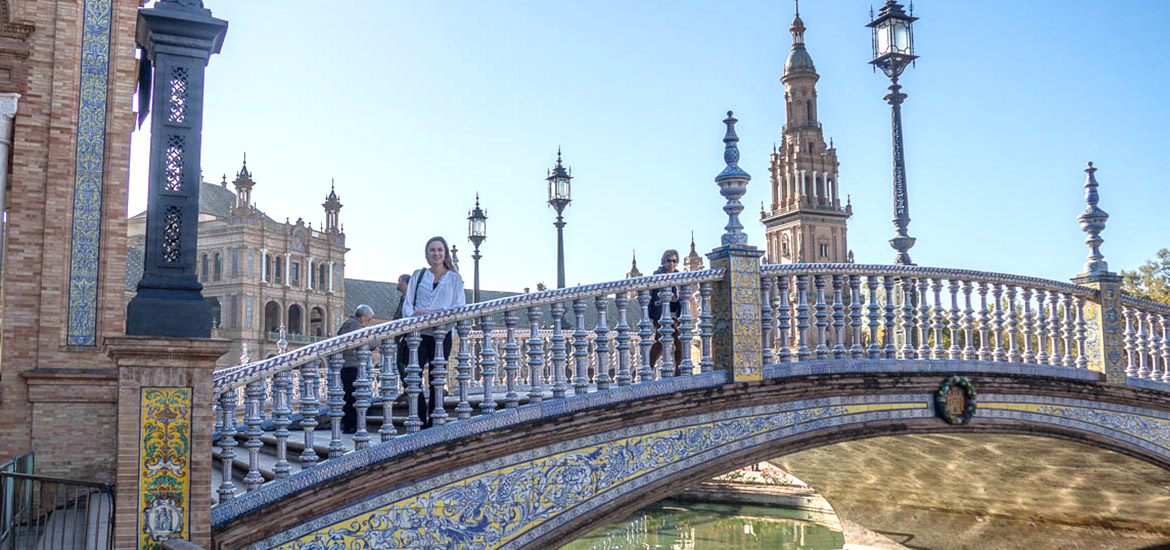Our Portugal & Andalucia Trip
Lisbon | Sintra | Lagos | Seville | Granada | Ronda | Cordoba
On our tour of Andalucia, the stunning capital of Seville snagged our hearts from our first late-night walk from the bus station through the gilded, lantern-lit lanes of its historic heart.
During our 2-day itinerary, fueled with sangria, tapas and jamon, we toured the indomitable Catedral de Sevilla, strolled the Mudéjar Christian-Islamic influenced Real Alcázar, and returned day and night to the romantic Plaza de España. We also saw flamenco, a can’t-miss experience.
Day 1
We opted to fit the two largest sightseeing destinations into the same day, with Real Alcázar in the morning and the Cathedral in the afternoon.
Real Alcázar


As architecture and history buffs, we were drawn to the Andalucia region for the exact experience this tour had to offer: Gorgeous 10th-century Moorish arches, Islamic inscription adorning walls and the unique mesh of Christian and Muslim style uniquely known in this region of Spain called Mudéjar.
The Alcázar is one of many structures were Christian buildings vied for prominence on old Islamic remains, a back-and-forth of hundreds of years of reconstruction that gave us gems like the sprawling Alhambra or Cordoba’s stunning chapel-in-a-mosque Mezquita.
Famous Catholic rulers Isabella and Fernando called the Real Alcázar their home, and the upper levels still serve as a residence to the royal family. These royal rooms can be visited with an additional ticket purchased in advance.





Tickets: I bought our tickets online the night before and we lined up for the earliest morning time slot. We weren’t able to see the royal palace rooms, which were sold out for months on either end of our arrival in November, so if you want to see those you’ll need to buy further in advance. The audioguide costs extra, but was extremely informative.
Church of the Divine Salvador

We came here for a quick peek and to buy a combo ticket with the Cathedral that would allow us to walk by the lines to get inside. The pink facade houses a beautiful Baroque altar.
Catedral de Sevilla (Seville Cathedral)


With a ticket purchased in advance at the church listed above, you can walk right by the massive line and start exploring. Of all the roomy cathedrals I’ve seen from Prague (St. Vitus) to London (St. Paul), the Catedral de Sevilla, clocking in as the world’s third largest church and world’s largest in the Gothic style, blew me away the moment I stepped inside.
The cavernous nave stretches out of sight in a gilded hall of chapels, ornate choir loft, and the staggering High Altar piece detailed with scenes from the Life of Christ. Christopher Columbus’ tomb is held on the shoulders of allegorical statues of the four kingdoms of Spain, and a treasury of reliquaries, crosses gilded with silver, gold and exotic tortoiseshell, and one of the world’s largest pearls carved into the body of a cherub in the Crown of Virgen de los Reyes, Spain’s priciest crown.






We spent about 40 minutes touring the inside, then climbed up to the La Giralda bell tower. Named for its bronze weather vane topper (a replica which you can see up-close outside the Cathedral entrance), the tower was once a Muslim minaret repurposed during the Reconquista, so the approach up involves a series of ramps.
The top is jam-packed with viewers, so we had to wait our turn to peak out over the city and the court of orange trees below. Oranges are a special sight all over Seville, a perfume and ornament to the beautiful streets, but the fruits themselves are allegedly too bitter to eat fresh and make a better ingredient in liqueur.





Barrio Santa Cruz

We stayed at the Hotel Amadeus for three nights, a beautiful composer-themed boutique hotel tucked into a quaint alley in this neighborhood. In the Plaza Virgen de los Reyes, music floated through the empty space by night and horse carriages and tourists flocked by day. We wandered through this area often in our explorations and it became a special place for me.



Metropol Parasol
….we couldn’t find out how to get on the top of this local landmark. Was it closed? Were we sauced on sangria and manzanilla? Here’s an urban art shot of my husband, at any rate.

Eating & Drinking
We ate lunch at a great tapas place called Sal Gorda, where in a constant quest for Spanish ham, I was keen to try the croquetas de jamon Iberico. Sangria options along the street are plentiful, as are tempting pastries.

Day 2
These days in Seville were leisurely by our traveling standards, and we followed the flow of life by getting up late and staying out for dinner past 8 pm. On a second day we visited the Plaza de España and surrounding María Luisa Park, took our time at a couple museums and walked along the Guadalquivir River to Triana.
Plaza de España

Before 11 am, this lovely contribution to the World Fair of 1929 is almost empty for exploration, and we enjoyed strolling over the colorful tiled bridges before the inner section was cordoned off for a military awards function (the Plaza houses various government offices, including the army). The plaza was constructed for pure admiration and Spanish pride, and features tiled historical scenes from the 49 provinces.



At night, the facade transforms into a romantic, near-private walking area as the fountain glows with color.



Parque de María Luisa

The nearby Maria Luisa Park complemented the Plaza de España as host for World Fair functions and is now a perfect place to enjoy a sunny stroll through botanical gardens, monuments and historical pavillions.


We found ourselves on the eastern end at the Plaza de America, where a pretty pond anchors the Museum of Arts and Traditions and the Archeological Museum. Oh, and THERE ARE ALSO BIRDS.
How much fun can you have with €1.50 bird food and fifty aggressive pigeons? So much fun.



Archeological Museum of Seville
Always suckers for anything Roman, we ducked in here after our pigeon encounter for some Andalucian archeological history.

Torre del Oro
After exploring the plaza, we walked north along the river on a pedestrian walkway covered with pergolas and dripping wisteria. The Torre del Oro was an important watchtower for 13th-century city defenses. We didn’t go inside the museum, but kept north along the river to cross the Puente de Isabel bridge into Triana. The skyscraper in the picture is the controversial Seville Tower.


Triana
The old quarter on the west bank of the river was more slice-of-life Seville than anything we had seen in the city center, and worth a walkthrough. Tiny shops and markets spilled with local patrons, who snacked on shrimp and picked up groceries. We strolled around residential streets and through the Triana Market before crossing back over the river for lunch at Bartolomea, the sister restaurant to the super-busy La Brunilda’s tapas.



General Archive of the Indies (Archivo de Indias)
Once the merchant’s exchange in ancient days, the Archive now houses some historical documents and maps, and is free to visit. At the time of our visit, we stumbled into one of the best-produced rotating exhibitions I’d ever seen: “El viaje más largo,” the fascinating story of Magellan told through beautiful displays in the moodily lit hall. I’d check to see if there is anything exhibiting here to make it worth it.

Flamenco

Entertainment and performances don’t often make it on our travel itineraries, but I am glad we made an exception for Seville’s famous native art, an Andalucian staple of singing, clapping, stomping and twirling dresses.
Attending at Casa de Flamenco was simple: I bought tickets online the day before, and showed them on our phone at the door. I was worried about being held captive to a “tourist” experience, but they kept it casual and approachable. We just went inside the hall, took a seat, and the performance began. It was passionate and moving, and one of the most memorable things on our trip.
We stayed in Seville three nights, then continued our Andalucian journey with a train to Granada in the morning.



One thought on “Seville: A 2 Day Itinerary”
Comments are closed.